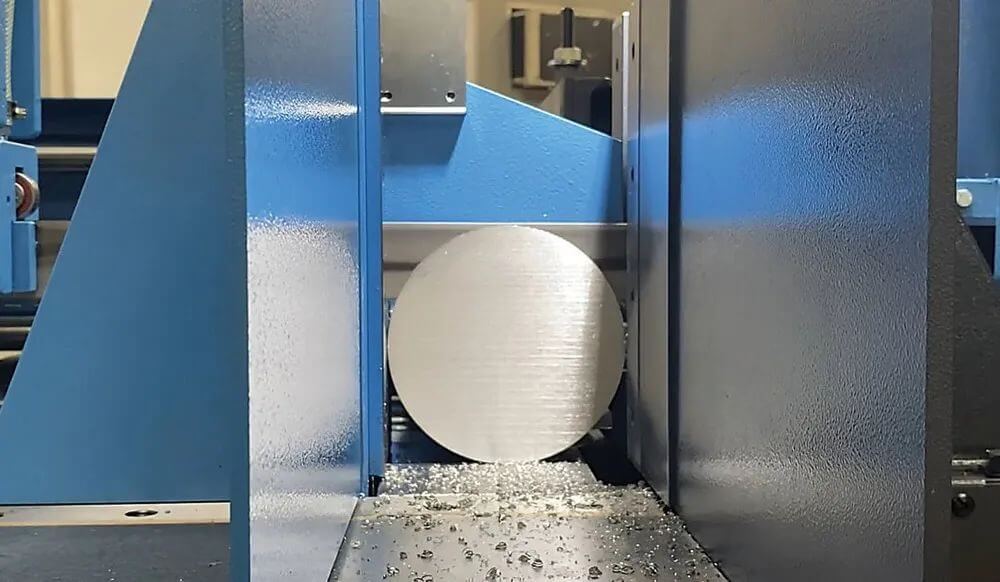Cutting is not a brute force job: Use carbide band saw blades to achieve smarter processing
When sawing difficult-to-process materials (such as titanium alloys, stainless steel, heat-resistant alloys and surface-hardened metals), carbide tooth band saw blades have become widely used tools due to their excellent cutting efficiency and durability. In recent years, more and more users have begun to apply them to the processing of ordinary materials and found that they have fast cutting speeds, good surface finish, and can increase the service life by about 20% compared to traditional bimetallic saw blades.
 1. Tooth structure and geometry
Common tooth shapes of carbide band saw blades include three-tooth cutting and trapezoidal grinding teeth. Among them, the three-tooth cutting tooth shape usually adopts a positive rake angle design, which helps to quickly “bite” the material and form chips in high-strength or high-hardness materials, and is suitable for efficient production scenarios. When processing surface-hardened materials (such as cylinder rods or hydraulic shafts), it is more recommended to use a negative rake angle tooth shape. This structure helps to “push” the hard surface layer under high heat conditions, thereby completing the cutting smoothly.
For abrasive materials such as cast aluminum, band saw blades with wide tooth pitch and wide cutting groove design are more suitable, which can effectively reduce the clamping force of the material on the back of the saw blade and extend the tool life.
2. Different saw blade types and their applicable scope
· Small diameter materials (<152mm): Suitable for carbide saw blades with three-tooth structure and positive rake angle tooth shape, with good cutting efficiency and material adaptability.
· Large diameter materials: It is recommended to use saw blades with multi-edge design, usually grinding up to five cutting surfaces on each tooth tip to enhance the cutting ability and improve the material removal rate.
· Surface hardening hardware: Negative rake angle and three-tooth saw blades should be selected, which can achieve high-temperature cutting and fast chip removal, and effectively cut through the outer hard shell.
· Non-ferrous metals and cast aluminum: Suitable for saw blades with wide tooth pitch design to avoid grooving clamping and reduce early failure.
· General cutting scenarios: It is recommended to use general carbide band saw blades with neutral or small positive rake angle tooth shape, which are suitable for a variety of material shapes and cutting requirements.
3. The influence of tooth type on cutting quality
Different tooth types correspond to different chip formation methods. For example, one design uses four ground teeth to form seven chips. During the cutting process, each tooth evenly shares the load, which helps to obtain a smoother and straighter cutting surface. Another design uses a three-tooth structure to cut out five chips. Although the surface roughness is slightly higher, the cutting speed is faster, which is suitable for processing scenarios where efficiency is prioritized.
4. Coating and cooling
Some carbide saw blades provide additional coatings, such as titanium nitride (TiN) and aluminum titanium nitride (AlTiN), to improve wear resistance and heat resistance, and are suitable for high-speed and high-feed applications. It is worth noting that different coatings are suitable for different working conditions, and whether to use coatings needs to be considered comprehensively based on specific application scenarios.
1. Tooth structure and geometry
Common tooth shapes of carbide band saw blades include three-tooth cutting and trapezoidal grinding teeth. Among them, the three-tooth cutting tooth shape usually adopts a positive rake angle design, which helps to quickly “bite” the material and form chips in high-strength or high-hardness materials, and is suitable for efficient production scenarios. When processing surface-hardened materials (such as cylinder rods or hydraulic shafts), it is more recommended to use a negative rake angle tooth shape. This structure helps to “push” the hard surface layer under high heat conditions, thereby completing the cutting smoothly.
For abrasive materials such as cast aluminum, band saw blades with wide tooth pitch and wide cutting groove design are more suitable, which can effectively reduce the clamping force of the material on the back of the saw blade and extend the tool life.
2. Different saw blade types and their applicable scope
· Small diameter materials (<152mm): Suitable for carbide saw blades with three-tooth structure and positive rake angle tooth shape, with good cutting efficiency and material adaptability.
· Large diameter materials: It is recommended to use saw blades with multi-edge design, usually grinding up to five cutting surfaces on each tooth tip to enhance the cutting ability and improve the material removal rate.
· Surface hardening hardware: Negative rake angle and three-tooth saw blades should be selected, which can achieve high-temperature cutting and fast chip removal, and effectively cut through the outer hard shell.
· Non-ferrous metals and cast aluminum: Suitable for saw blades with wide tooth pitch design to avoid grooving clamping and reduce early failure.
· General cutting scenarios: It is recommended to use general carbide band saw blades with neutral or small positive rake angle tooth shape, which are suitable for a variety of material shapes and cutting requirements.
3. The influence of tooth type on cutting quality
Different tooth types correspond to different chip formation methods. For example, one design uses four ground teeth to form seven chips. During the cutting process, each tooth evenly shares the load, which helps to obtain a smoother and straighter cutting surface. Another design uses a three-tooth structure to cut out five chips. Although the surface roughness is slightly higher, the cutting speed is faster, which is suitable for processing scenarios where efficiency is prioritized.
4. Coating and cooling
Some carbide saw blades provide additional coatings, such as titanium nitride (TiN) and aluminum titanium nitride (AlTiN), to improve wear resistance and heat resistance, and are suitable for high-speed and high-feed applications. It is worth noting that different coatings are suitable for different working conditions, and whether to use coatings needs to be considered comprehensively based on specific application scenarios.